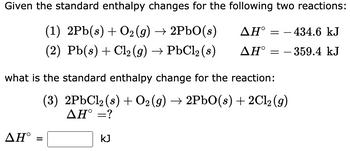
Chemistry
10th Edition
ISBN: 9781305957404
Author: Steven S. Zumdahl, Susan A. Zumdahl, Donald J. DeCoste
Publisher: Cengage Learning
expand_more
expand_more
format_list_bulleted
Concept explainers
Question

Transcribed Image Text:Given the standard enthalpy changes for the following two reactions:
(1) 2Pb(s) + O₂(g) → 2PbO(s)
ΔΗ°
(2) Pb(s) + Cl₂(g) → PbCl₂ (s)
ΔΗ°
ΔΗ°
what is the standard enthalpy change for the reaction:
(3) 2PbCl₂ (s) + O2 (g) → 2PbO(s) + 2Cl₂(g)
ΔΗ° =?
=
= 434.6 kJ
- 359.4 kJ
KJ
=
Expert Solution
arrow_forward
Step 1
Trending nowThis is a popular solution!
Step by stepSolved in 5 steps

Knowledge Booster
Learn more about
Need a deep-dive on the concept behind this application? Look no further. Learn more about this topic, chemistry and related others by exploring similar questions and additional content below.Similar questions
- Given the standard enthalpy changes for the following two reactions: (1) 2Hg(1) + O2(g) 2HgO(s) AH° = -181.6 kJ (2) Hg(1) + Cl2(g)→HgCl2(s) AH° = -224.3 kJ what is the standard enthalpy change for the reaction: (3) 2HgCl2(s) +02(g) )→2HgO(s) + 2Cl½(g) AH° = ? kJ Try Another Version 3 item attempts remaining Submit Answerarrow_forwardDetermine the enthalpy (in kJ/mol) for the reaction 3 SiCl₄ (s) + 4 Fe (s) → 4 FeCl₃ (s) + 3 Si (s) (Please show steps)arrow_forwardWhen a 3.00 g sample of RbBr is dissolved in water in a calorimeter that has a total heat capacity of 1.89 kJ · K¯¹, the temperature decreases by 0.210 K. Calculate the molar heat of solution of RbBr. AH S = soln kJ/molarrow_forward
- I am confused on how to find the enthalpy change with this information. Thank you!arrow_forwardA calorimeter contains 24.0 mL of water at 11.0 °C. When 2.20 g of X (a substance with a molar mass of 52.0 g/mol) is added, it dissolves via the reaction and the temperature of the solution increases to 25.0 °C. Calculate the enthalpy change, AH, for this reaction per mole of X. Assume that the specific heat of the resulting solution is equal to that of water [4.18 J/(g · °C)], that density of water is 1.00 g/mL, and that no heat is lost to the calorimeter itself, nor to the surroundings. Express the change in enthalpy in kilojoules per mole to three significant figures. ► View Available Hint(s) AH = X(s)+H2O(1)→X(aq) VE ΑΣΦ ? kJ/molarrow_forwardPlease answer both questionsarrow_forward
- Determine the standard enthalpy of formation of Fe2O3(s) given the thermochemical equations below. Fe(s) + 3 H2O(l) → Fe(OH)3(s) + 3/2 H2(g) ΔrH° = +160.9 kJ H2(g) + 1/2 O2(g) → H2O(l) ΔrH° = –285.8 kJ Fe2O3(s) + 3 H2O(l) → 2 Fe(OH)3(s) ΔrH° = +288.6 kJarrow_forwardUse Hess's law to calculate enthalpy change. Given the following two reactions: (1)Fe(s) + Cl₂(g) →→→FeCl₂(s) (2)Mg(s) + Cl₂(g) MgCl₂(s) AH(2) calculate the enthalpy change for the following reaction: (3) FeCl₂(s) + Mg(s) Fe(s) + MgCl₂(s) Check & Submit Answer Show Approach AH(1) = -341.8 kJ =-641.3 kJ AH(3) kJarrow_forwardSection 5.6 You place 0.0750 g of magnesium chips in a coffee-cup calorimeter and then add 100.0 mL of 1.00 M HCI. The reaction that occurs is: -> Mg (s) + 2 HCI (aq) → H2 (g) + MgCl2 (aq) The temperature of the solution raises from 20.15 °C to 23.29 °C. What is the enthalpy change or the reaction per mole of Mg? Assume that the specific heat capacity of the solution is 4.20 J/g K and the density of the solution is 1.00 g/mL. 412 kJ/mol 428 kJ/mol -412 kJ/mol -428 kJ/molarrow_forward
- A chemist measures the enthalpy change AH during the following reaction: 2 Al(OH)3(s)→Al,03(s) + 3 H,0(1) AH=41. kJ Use this information to complete the table below. Round each of your answers to the nearest kJ/mol. reaction ΔΗ x10 2 Al,0, (s) + H,0(1) Al(OH), (s) kJ 3 3 Al, O, (s) + 3H,0(1) → 2A1(OH), (s) kJ 3 Al(OH), (s) → Al, 0, (s) + H,0() |kJ 3arrow_forwardCalculate ΔH for the reaction NO(g) + O(g) → NO2(g) given the following information: NO(g) + O3(g) → NO2(g) + O2(g) ΔH = -198.9 kJ O3(g) → 3/2O2 ΔH = -142.3 kJ O2(g) → 2 O(g) ΔH = 495.0 kJarrow_forwardWhen a 7.00 g sample of KCl is dissolved in water in a calorimeter that has a total heat capacity of 3.76 kJ⋅K−1, the temperature decreases by 0.430 K. Calculate the molar heat of the solution of KCl.arrow_forward
arrow_back_ios
SEE MORE QUESTIONS
arrow_forward_ios
Recommended textbooks for you
 ChemistryChemistryISBN:9781305957404Author:Steven S. Zumdahl, Susan A. Zumdahl, Donald J. DeCostePublisher:Cengage Learning
ChemistryChemistryISBN:9781305957404Author:Steven S. Zumdahl, Susan A. Zumdahl, Donald J. DeCostePublisher:Cengage Learning ChemistryChemistryISBN:9781259911156Author:Raymond Chang Dr., Jason Overby ProfessorPublisher:McGraw-Hill Education
ChemistryChemistryISBN:9781259911156Author:Raymond Chang Dr., Jason Overby ProfessorPublisher:McGraw-Hill Education Principles of Instrumental AnalysisChemistryISBN:9781305577213Author:Douglas A. Skoog, F. James Holler, Stanley R. CrouchPublisher:Cengage Learning
Principles of Instrumental AnalysisChemistryISBN:9781305577213Author:Douglas A. Skoog, F. James Holler, Stanley R. CrouchPublisher:Cengage Learning Organic ChemistryChemistryISBN:9780078021558Author:Janice Gorzynski Smith Dr.Publisher:McGraw-Hill Education
Organic ChemistryChemistryISBN:9780078021558Author:Janice Gorzynski Smith Dr.Publisher:McGraw-Hill Education Chemistry: Principles and ReactionsChemistryISBN:9781305079373Author:William L. Masterton, Cecile N. HurleyPublisher:Cengage Learning
Chemistry: Principles and ReactionsChemistryISBN:9781305079373Author:William L. Masterton, Cecile N. HurleyPublisher:Cengage Learning Elementary Principles of Chemical Processes, Bind...ChemistryISBN:9781118431221Author:Richard M. Felder, Ronald W. Rousseau, Lisa G. BullardPublisher:WILEY
Elementary Principles of Chemical Processes, Bind...ChemistryISBN:9781118431221Author:Richard M. Felder, Ronald W. Rousseau, Lisa G. BullardPublisher:WILEY

Chemistry
Chemistry
ISBN:9781305957404
Author:Steven S. Zumdahl, Susan A. Zumdahl, Donald J. DeCoste
Publisher:Cengage Learning

Chemistry
Chemistry
ISBN:9781259911156
Author:Raymond Chang Dr., Jason Overby Professor
Publisher:McGraw-Hill Education

Principles of Instrumental Analysis
Chemistry
ISBN:9781305577213
Author:Douglas A. Skoog, F. James Holler, Stanley R. Crouch
Publisher:Cengage Learning

Organic Chemistry
Chemistry
ISBN:9780078021558
Author:Janice Gorzynski Smith Dr.
Publisher:McGraw-Hill Education

Chemistry: Principles and Reactions
Chemistry
ISBN:9781305079373
Author:William L. Masterton, Cecile N. Hurley
Publisher:Cengage Learning

Elementary Principles of Chemical Processes, Bind...
Chemistry
ISBN:9781118431221
Author:Richard M. Felder, Ronald W. Rousseau, Lisa G. Bullard
Publisher:WILEY